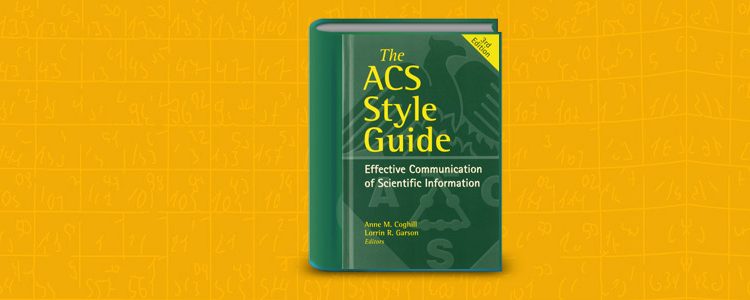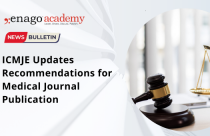An Overview of the ACS Style Guide

What is an ACS Style Guide?
The ACS Style Guide is the essential writing guide for the 51 scholarly journals published by the American Chemical Society (ACS). This scientific society, founded in 1876 at New York University, has over 158,000 members, all working in chemical engineering and associated fields. The third edition of the ACS Style Guide: Effective Communication of Scientific Information, published in 2006, is available online and in print. The main difference between the ACS Style Guide and other guides is its scientific focus—The Chicago Manual of Style focuses on academic books and journals; the AP Stylebook, journalism and law; and APA Style, the social sciences.
While the ACS Style Guide is essential for authors in the field of chemistry, it is used by authors in other STEM disciplines also. With expert instructions on challenges such as ethics in science writing and submission standards, it is used as a resource in teaching students how to effectively communicate scientific information.
How Does ACS Style Differ from Other Guides?
As mentioned, the primary difference between ACS and other guides is its focus on chemistry. The chemical sciences use many abbreviations, and the titles of journals and conference proceedings are often presented with a standard abbreviation. The ACS Style Guide has a long listing of abbreviations for over 1000 heavily used chemistry journals. The guide also includes information on the following topics:
- Ethics in Scientific Publication (Chapter 1)
- Electronic Submission of Manuscripts Using Web-Based Systems (Chapter 5)
- Numbers, Mathematics, and Units of Measure (Chapter 11)
- Names and Numbers for Chemical Compounds (Chapter 12)
- Conventions in Chemistry (Chapter 13)
- Chemical Structures (Chapter 17)
In modern scientific writing, documents are considered as vehicles of data for readers. The ACS Style Guide introduces the term datument which is defined as a data-focused entity i.e. a container for data and its associated descriptions.
ACS Writing Style General Formatting Guidelines
While the ACS Style Guide does not have specific guidelines for font, margins, and other elements for the text and format of a paper or report, general formatting guidelines are considered a good practice if the instructor, professor, or journal guidelines do not direct any rules.
- Margins should be set 1 inch on all sides of the page.
- The font for the paper must be consistent. Maintain a 12-point Times New Roman font.
- Double Space the entire research paper, including quotations, notes, and the list of works cited. Leave one space after a period or other concluding punctuation mark, unless your instructor prefers two spaces.
- Use a hanging indent to create proper spacing of 0.5” for your reference list page.
ACS Citation Guidelines
One important guideline in the ACS Style Guide is the format for citing a website which is essential for scholarly authors. The ACS Style guide includes two forms of citations: “In-text Citations” and “Reference List”.
ACS Citation Example: In-text Citation
Superscript numbers
- At the end of the cited information: The source number as mentioned in the reference list is mentioned as superscript at the end of the cited text after the punctuation.
Example: A thin layer of trimethylhydroxysilane makes sand hydrophobic.1
- Within the cited information: The source number as mentioned in the reference list is mentioned as superscript alongside the author’s name while quoting the statement.
Example: Samuel1 states that a thin layer of trimethylhydroxysilane make sand hydrophobic.
Italic numbers
- At the end of the cited information: The source number as mentioned in the reference list is mentioned in italics within parenthesis at the end of the cited text after the punctuation.
Example: A thin layer of trimethylhydroxysilane makes sand hydrophobic. (1)
- Within the cited information: The source number as mentioned in the reference list is mentioned in italics within parenthesis alongside the author’s name while quoting the statement.
Example: Samuel (1) states that a thin layer of trimethylhydroxysilane make sand hydrophobic.
Author name and year of publication
- At the end of the cited information: Mention the author’s name and the year of publication within parenthesis at the end of the cited text.
Example: A thin layer of trimethylhydroxysilane makes sand hydrophobic. (Samuel, 2004).
- Within the cited information: Mention the year of publication at the end of the statement.
Example: Samuel states that a thin layer of trimethylhydroxysilane make sand hydrophobic. (2004).
Note: For two authors, use “and”: Samuel and Greg. For more than two authors use “et al.”: Samuel et al.
ACS Citation Example: Reference List
The reference list provides detailed information on the sources you referred to in the research for your paper.
Each entry should include the following reference components:
- Author or editor
- Publication Date
- Publication information
General Guidelines for Formatting a Reference List
- Every reference list must begin on a new page.
- It is recommended to place the text in left-alignment on the page.
- Use a hanging indent to correctly format the references list: indent all lines in a reference entry except for the first one.
Ordering the References List
The order of your references list depends on what kind of in-text citations you used: author-date, or numerical (parenthetical or superscript).
- If you used numerical (parenthetical or superscript) in-text citations, put your references in numerical order.
- If you used author-date in-text citations, order references in alphabetical order by last name of the first author.
Referencing Different Sources in ACS Style
Academic Books
Print Book Citation Format
Author 1; Author 2; etc. Title of Book, Edition Number; Series Information If Applicable; Publisher, Year.
Online Book Citation Format
Author 1; Author 2; Author 3; etc. Book Title, edition information; Series Information If Applicable; Publisher, Year. DOI or URL
Chapter in Book Citation Format
Author 1; Author 2; etc. Title of Chapter. In Title of Book, Edition Number; Series Information, Volume Number; Publisher, Year; pp Pages Used. DOI or URL
Edited Book Citation Format
Book Title, Edition Number; Editor 1, Editor 2, etc., Eds.; Series Information (if any); Publisher, Year. DOI or URL
Book in Series Citation Format
Author 1; Author 2; etc. Title of Chapter. In Title of Book; Editor 1, Editor 2, etc., Eds.; Series Information, Volume Number; Publisher, Year; pp Pages Used. DOI or URL
Journal Articles
Print Journal Articles Citation Format
Author 1; Author 2; Author 3; etc. Title of Article. Journal Abbreviation Year, Volume, Inclusive Pagination.
Author 1; Author 2; Author 3; etc. Journal Abbreviation Year, Volume, Inclusive Pagination.
Online Journal Articles Citation Format
- For online scholarly articles found electronically, use the following format:
Author 1; Author 2; Author 3; etc. Title of Article. Journal Abbreviation [Online] Year, Issue, Inclusive Pagination. Complete URL (accessed Date).
- For articles found through an electronic database, include the database name in the citation. Replace the article’s URL with that of the database.
Author 1; Author 2; Author 3; etc. Title of Article. Journal Abbreviation [Online], Date, Inclusive Pagination. Database Name. Complete URL of database (accessed Date).
- For articles published online in advance of the print issue, use this format:
Author 1; Author 2; Author 3; etc. Title of Article. Journal Abbreviation [Online early access]. DOI. Published Online: Date. Complete URL (accessed Date).
Approaching the ACS Style Guide
Academic writers that are new to the ACS style may ponder on the best way to approach the guide. One way is to consider the guide’s general organization. It is divided into two general sections:
- Part 1–Scientific Communication
- Part 2–Style Guidelines
In each part, the chapters are written by different contributors rather than the entire guidebook being authored by a single entity. Authors who are familiar with The Chicago Manual of Style know that it has three general sections: The Publishing Process, Style and Usage, and Documentation. The Associated Press Stylebook is organized by subject (business, sports, media law, etc.).
When using the ACS Style Guide for a scholarly article it is necessary to answer a question by considering the scope of your question when using the guide. Is it more general to the subject of scientific writing (Part 1) or more specific to language, format, or style (Part 2)? Once this has been determined, it is easy to locate the appropriate chapter and find the answer that is needed.
Did you ever draft a manuscript using the ACS Style Guide? Could you mention all the required elements while citing your sources? Let us know in the comments section below! You can also visit our Q&A forum for frequently asked questions related to different aspects of research writing and publishing answered by our team that comprises subject-matter experts, eminent researchers, and publication experts.









